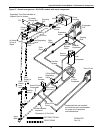
Split System Models
57
7.2.2 Low Voltage
The control cable between the condensing unit and the evaporator unit is connected between termi-
nals 1,2 and 3 on the terminal strip in the evaporator unit and the condensing unit control box. A
fourth wire is required on systems with hot gas bypass. NEC Class 1 wiring is required. Glycol-cooled
units also require a two-wire control connection to the drycooler and pump package.
7.3 Piping Considerations
7.3.1 Refrigerant Loop
NOTICE
Risk of improper refrigerant charge. Risk of equipment damage, environmental degradation
and violation of national, state and local law.
Follow all applicable codes for handling refrigerant.
R22 and R407C are similar in properties—proper safety equipment and proper refrigeration
tools are required on both types. Check unit nameplate for correct refrigerant type before
topping off or recharging a system.
R407C refrigerant must be introduced and charged from the cylinder only as a liquid.
NOTICE
Risk of improper piping installation. Can cause contamination of hygroscopic oil with water.
When installing field piping, care must be taken to protect all refrigerant lines from the
atmosphere, especially when using refrigerants, such as R407C which requires use of polyol
ester oils. Do not allow the piping to stand open to air for more than 15 minutes. Units
designed for R407C have a compressor that contains polyol ester oil, which is very
hygroscopic; that is, it quickly absorbs water from the air. The longer the compressor piping is
left open to air, the harder it will be to fully evacuate. If left open too long, the polyol ester oil
may need to be replaced before achieving the required vacuum level.
All split systems require two refrigerant lines (an insulated copper suction line and a copper liquid
line) between the evaporator and the condensing unit.
Two possible methods exist for installing the copper suction and liquid lines.
1. Using an optional Sweat Adapter Kit and hard piping between the two units.
2. Using optional pre-charged line sets (for 3-ton models only).
All refrigeration piping should be installed with high temperature brazed joints. Prevailing good
refrigeration practices should be employed for piping supports, leak testing, evacuation, dehydration,
and charging of the refrigeration circuits. The refrigeration piping should be isolated from the build-
ing by the use of vibration isolating supports.
It is important to handle the pre-charged lines for 3-ton units with care so they will not get kinked or
damaged. Use tube benders and make all bends before making connections to either end. Coil any
excess tubing in a horizontal plane with the slope of the tubing toward the condensing unit.
To prevent tube damage when sealing openings in walls and to reduce vibration transmission, use a
soft flexible material to pack around the tubes.
When installing remote condensing units mounted above the evaporator, the suction gas line should
be trapped at the evaporator. This trap will retain refrigerant oil in the off cycle. When the unit
starts, oil in the trap is carried up the vertical riser and returns to the compressor.
NOTE
Complete all piping and evacuate lines before connecting quick connects when using an
optional sweat adapter kit and field installed hard piping.
Follow all proper brazing practices including a dry nitrogen purge to maintain system
cleanliness.


















